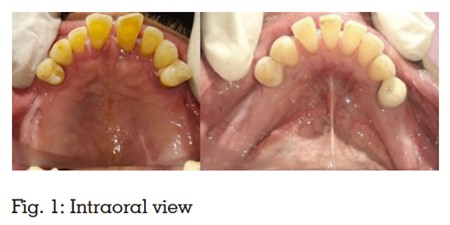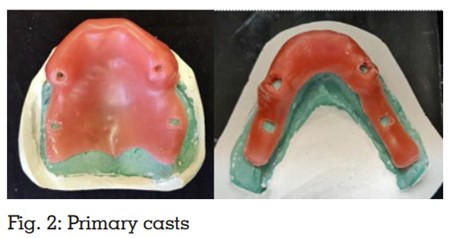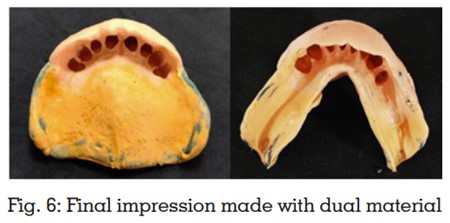

Acrylic partial dentures are still the first line of treatment for the partially edentulous in many countries. Though there are many physiologic and functional techniques recommended to record the supporting form of edentulous distal extension areas, they may not be used in practice because of being cumbersome. Simplified impression techniques may increase the confidence of beginners in the treatment concept of acrylic partial dentures. A novel, simplified and economical impression technique that adheres to principles of RPD impression making is presented. A single tray was used to record the dentulous and edentulous area in a single step by using two impression materials.
Key words: Acrylic Partial Denture, Distal Extension, Simplified Impressions, Single Tray
Despite their frequent use and popularity, the
proper technique of Acrylic partial denture (APD)
fabrication is not found in textbooks or manuals, and prosthodontists maintain a regretful attitude
towards their use in spite of their proven benefits.
The advent of Removable partial dentures
(RPD) may have preceded complete dentures
in India. The popularity of (APD) can be traced
back to the latter half of the twentieth century1.
India is a country of more than 1.3 billion people
with different socioeconomic demographics. A
study conducted in Northern India revealed that
between the ages of 43 and 53, 41.9% of females
from rural areas and 48.2% urban females were
partial edentulous while 58% of rural males and
51.7% urban males respectively were partially
edentulous.2
Acknowledging the financial
constraints that individuals face, the acrylic
partial dentures have been an economical and
viable alternative to cast partial dentures in
other countries too 3,4.
Christensen stated that the RPD impression techniques taught in dental schools are too time consuming and not suitable for routine use in practice. He further suggested that Dental curriculum
should include simple and dependable methods
so that the novice doesn’t lose faith in RPD5.
In this paper we describe a novel, easy to follow
and economical technique of recording an
impression for a case requiring maxillary and
mandibular distal extension APDs.
A 56-year-old female patient was referred to the
Department of Prosthodontics, for replacement
of missing teeth. On clinical examination it was
found that the patient had several missing teeth
in both the arches (Kennedy class 2 situation in
both maxillary and mandibular arches) (Fig.1).
The teeth present were 11, 12, 13, 14, 21, 22, 23,
24 in the maxillary arch and 31, 32, 33, 34, 41, 42,
43, 44 in the mandibular arch. Grade I mobility
was observed with 11, 21, 22 and 31, 32, 41
after completion of periodontal therapy. Various
possible fixed and removable treatment options
were given to the patient, but due to monetary
reasons patient opted for acrylic removable
partial dentures.






With the advances in dentistry, various definitive
impression techniques (physiologic/ functional)
and impression materials have been used to
fulfill the objectives of impression making.6
However, as most of the impression techniques
are tedious, a single impression made with
elastomeric materials has been proposed by
many. 7,8 One of the well-established functional
impression material is Zinc-oxide eugenol
impression paste9
. Hence a simplified technique
using economical materials like zinc oxide
eugenol impression paste and alginate would
benefit the dental fraternity in making efficient
acrylic partial dentures, especially in the more
demanding Kennedy’s class I and class II
partially edentulous arches. This is particularly
true for developing nations where acrylic partial
dentures are mainstay. Hence, an innovative
and simplified approach using cost-effective
materials in a single custom tray was adopted
to overcome the difficulties associated with two
tray approach which may be commonly followed
in Asian developing countries.10
The single tray method can save clinical
time without compromising the objectives of
impression making. Clinical studies may be
conducted to compare the efficiency of the novel
single tray impression versus the conventionally
followed two tray technique. Simplified, efficient and economical impression techniques should
become a part of the teaching curriculum.
The advantages of the current technique are:-
In conclusion, the innovative impression
technique discussed in this article marks
a significant advancement in the field of
prosthodontics, particularly for the fabrication
of distal extension acrylic partial dentures. This
novel approach offers numerous advantages,
such as improved accuracy, enhanced patient
comfort, and streamlined clinical workflow. By simplifying the traditionally intricate process
of capturing accurate impressions in distal
extension cases, this technique not only reduces
the potential for errors but also minimizes patient
discomfort, ultimately leading to higher patient
satisfaction.
Moreover, the simplified impression technique
outlined in this article holds great promise
for the broader dental community. It has the
potential to save both time and resources while
maintaining high-quality results, making it an
attractive option for dental practitioners seeking
to optimize their clinical practice.